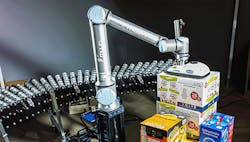How to safely deploy automation around humans with facility changes
Joe Campbell is a long-time veteran of the robotics and automation industry. After executive assignments in sales, marketing, operations and customer service with robot, system-integrator and engineering companies, Campbell is head of strategic marketing for Universal Robots. A graduate of the University of Cincinnati, Campbell is a regular speaker, lecturer and author on manufacturing labor issues, as well as the technology and economic benefits of robots and factory automation.
What sorts of sensing technologies have improved the effectiveness and reliability of picking systems and conveyance systems?
Joe Campbell, head of strategic marketing, Universal Robots: Sensing technologies such as cameras have improved greatly in performance over the past decade, which has provided a boost to picking systems that have traditionally struggled with certain picking tasks—in particular, bin-picking tasks where objects are presented in an unstructured way.
Also read: Warehouse automation with the human touch
Companies deploying collaborative robots can choose from 2D, 2.5D and 3D cameras, which allows them to deploy the camera technology that is best suited to the application.
Visual sensing technology has improved, but to achieve the most advanced bin-picking capabilities, some type of intelligence beyond the camera itself is required—for example, one that handles vision processing, collision-free motion planning and autonomous real-time robot control (Figure 1).
Not only does this intelligence boost the effectiveness and reliability of picking systems, but it eliminates the complexity and risk usually associated with traditional bin-picking automation.
Which technologies have allowed warehouses to increase throughput rates while expanding product ranges and still maintaining accurate order fulfillment?
Joe Campbell, head of strategic marketing, Universal Robots: Warehouses need automation that is flexible and easy to deploy. Additionally, warehouses want automation that can, following a standard risk assessment, be deployed safely around humans without extensive physical fencing or other changes to the facility.
And, like their counterparts in the manufacturing sector, warehouses prefer automation that can easily handle high-mix/low-volume (HMLV) applications. Collaborative robots, or cobots, can provide all these features and benefits in one easy-to-deploy package.
You’ll find cobots deployed on a wide range of warehouse applications and in numerous configurations. Cobots have been deployed on warehouse bin-picking applications, inspection applications, packaging applications and palletizing/depalletizing applications. Cobots have been deployed upright on pedestals, upside-down on ceilings, and even mounted on autonomous mobile robots. Being able to use the same robot across so many applications and in such diverse configurations is a real boon for warehouse facilities of all sizes.
How have automated storage and retrieval systems' roles changed over the past 10 years?
Joe Campbell, head of strategic marketing, Universal Robots: The role of automated warehouse systems has changed over the past 15 years due to two main factors: the changing requirements of the warehousing sector and the emergence of collaborative automation. A decade ago, automation, from robot arms to mobile robots, was only for the largest warehouse companies because of the cost and complexity involved in every deployment.
The emergence of collaborative automation has created new possibilities for warehousing and logistics companies of all sizes. Warehouses want easy-to-use automation that is flexible and can handle a wide range of applications from bin-picking to palletizing in a HMLV environment. Cobots provide all this and more.
Given the extraordinary percentage of manual operation in most distribution centers, will the 24/7 fully autonomous warehouse order-fulfillment center ever become commonplace?
Joe Campbell, head of strategic marketing, Universal Robots: You’re right to highlight the fact that there is still a huge amount of manual work being performed in most warehouse facilities. However, warehouse companies are facing unprecedented labor shortages and rising labor costs. This is driving huge interest in automation. Automation can help warehouses stay productive and competitive without sacrificing production quality. And robots are a powerful tool for companies struggling in the face of ongoing labor shortages.
Will 24/7 fully automated warehouse facilities become commonplace? That depends on the warehouse sector. If 24/7 fully autonomous warehouses are a good match for most warehouse companies’ requirements and business models, then it will become commonplace. The technology is already there.
The most important thing for automation leaders is that we listen to the warehousing sector and focus our efforts on supporting the sector’s automation requirements as those requirements change over time.
Mike Bacidore is the editor in chief for Control Design magazine. He is an award-winning columnist, earning a Gold Regional Award and a Silver National Award from the American Society of Business Publication Editors. Email him at [email protected].
About the Author
Mike Bacidore
Editor in Chief
Mike Bacidore is chief editor of Control Design and has been an integral part of the Endeavor Business Media editorial team since 2007. Previously, he was editorial director at Hughes Communications and a portfolio manager of the human resources and labor law areas at Wolters Kluwer. Bacidore holds a BA from the University of Illinois and an MBA from Lake Forest Graduate School of Management. He is an award-winning columnist, earning multiple regional and national awards from the American Society of Business Publication Editors. He may be reached at [email protected]

Leaders relevant to this article:



